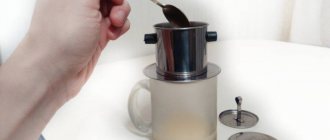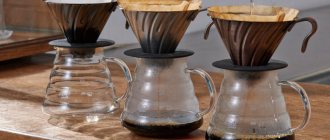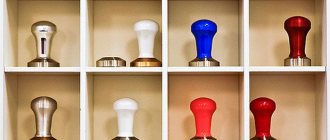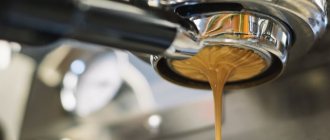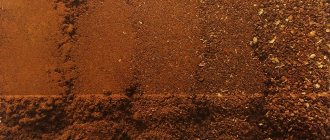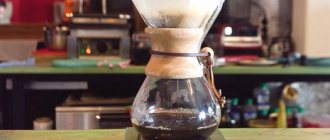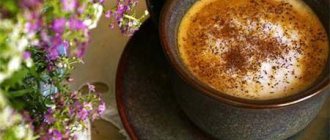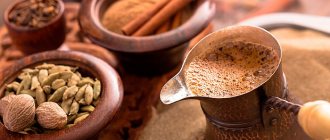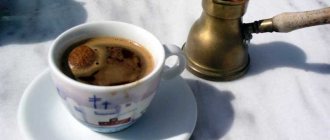The American Chemex coffee maker looks like a laboratory flask. Thanks to this similarity, it received the name chemax - from the word “chemistry”. Lovers of invigorating espresso prefer this design for the ability to quickly prepare coffee with a mild taste and rich aroma. Among the advantages of the coffee maker are ease of use and compactness. The taste of the drink depends on many nuances: from the time of grinding the beans to the filter bags used.
Enjoy your coffee!
And remember that our brewing method is not a dogma and there is always room for experimentation - try different beans, change the grind size or water temperature, try adding a few ice cubes or slices of frozen fruit to the drink so that hot, freshly brewed coffee immediately cools and becomes especially sweet. Of all the brewing methods, Chemex produces the most aromatic coffee.
Chemex: origin and device
Chemex is a fairly simple but effective device. It was invented in the 40s of the twentieth century by Peter Schlumbom , a famous chemist. He was a big fan of the coffee drink and sought to find a way to prepare it without being distracted from work. The result is a simple and convenient device that allows you to obtain coffee characterized by excellent taste.
Initially, the constituent elements of the kemesk were a flask and a glass funnel , which can be found in large quantities in any laboratory. They were connected using a clamp and a garter. Originally the joint was made of leather, today it is made of plastic. There are also Chemixes that do not have such a compound; a regular glass pen takes its place. The device has a long spout through which ready-made coffee is poured.
In order to brew coffee using this device, you will need a four-layer paper filter .
The invention turned out to be in demand and brought its creator popularity and considerable income. Even after all these years, Chemex remains in demand in the coffee industry.
Features of coffee prepared in a Chemex
When starting to brew a coffee drink using a Chemex, you need to consider the following points.
- In a Chemex you should brew only natural coffee from high-quality beans. Monosorts will be the best option for this, but mixtures should be abandoned, because This method of preparation reveals the coffee, reflecting all its flavor notes and shades.
- Brew coffee freshly roasted and freshly ground , because... Beans that have been sitting for more than two months after roasting lose their taste, and in this case you will not be able to get a good coffee drink.
- Coffee prepared in a Chemix turns out to be very hot, but due to the large volume of the flask and the wide funnel, it cools down quickly, which not everyone likes. Cooled coffee loses its taste.
Help with opening “Coffee to Go”.
Features of brewing coffee in a Chemex
Despite the simplicity of the device, there are certain rules for preparing a coffee drink using it. First of all, we must not forget about the following important points in preparing coffee, which directly affect the result.
Grinding
When preparing coffee in a Chemex, you should use a coarse grind . The ground coffee should have the appearance of sea salt . Subsequently, you can adjust the degree of grinding based on the preparation time of the coffee drink and your preferences.
Dosage of ground coffee
The optimal amount of coffee for a standard-sized Chemex (designed to make 3 cups of coffee) is 30 grams.
In general, the following ratio is correct: 60 grams are required for 1 liter of water. grains _ Based on these proportions, you can calculate the amount of coffee for each individual case.
Water temperature
Temperature has a significant impact on the taste of the finished drink. Depending on the type of coffee used for preparation, different temperatures are required. In this regard, it is worth experimenting, changing the temperature by one or two degrees to achieve the desired combination of flavors.
In order to brew coffee using a Chemex, the water must have a temperature of about 93 - 950C . You can get the required temperature as follows: remove the kettle with boiled water from the stove and let it cool for 1 minute.
Creator of Chemex
The extravagant American inventor, German by birth, lived in grand style and was literally bursting with discoveries. Having several thousand inventions to his name, he was scrupulous about saving his own time and valued convenience. A lover of food and drink, he was, among other things, a fan of coffee and sought, with the persistence of a real chemist, the formula for the ideal drink.
Subsequently, it was the Chemex, ingeniously composed of laboratory glassware and combining the simplest methods of filtration and extraction, that entered the list of world gastronomic achievements in the field of coffee brewing.
By the way, the chemist himself especially singled out this brainchild of his. Driving around New York in his Cadillac convertible, he bolted a gold-plated Chemex to his front door as a talisman.
Brewing Guide: Chemex
- Chemex and paper filter
- A good coffee grinder that produces a uniform grind that suits your needs
- Kettle with a narrow spout for pouring
- Scales (at least kitchen scales) and a stopwatch (you can use the one on your phone)
- Fresh coffee beans or, in the absence of a coffee grinder, pre-ground coarse coffee
Brewing parameters:
- Total brew time: 4 minutes
- Coffee: 25 g – for two cups
- Water: 425 g
- Coffee to water ratio: in our case 1:17, but according to SCA recommendations you can take parameters from 1:14 to 1:20
- Grind: coarse, about the size of sea salt
- Temperature: 92-96°C
* The water temperatures shown here are recommended by SCA. You can use a lower temperature of water, but there is a possibility of getting too acidic, unsweetened, astringent, “unripe” coffee. If you take the temperature too high, you can burn the coffee. The taste will, at best, reflect the taste of burnt sugar and dark chocolate; at worst, the extraction will take place very quickly and the drink will be so bitter that it will be impossible to correct it.
Step 1
Insert a paper filter, placing it in a triple layer towards the neck. Wet the filter by pouring hot water to remove the papery taste and warm the flask
Step 2
Pour out the water without removing the filter
Step 3
Place the Chemex on the scale, pour the ground coffee into the filter and reset the scale
Step 4
Turn on the timer and pre-wet: carefully pour in 80 ml of water in a thin stream over 30 seconds, without touching the edges. For uniform extraction, all coffee particles must be moistened. Pre-wetting helps degas the coffee so that the escaping gas does not interfere with the interaction between coffee and water.
* The amount of water for pre-wetting and at all stages will change if you change the parameters - take more or less coffee.
Step 5
We continue to pour water either in a continuous stream at an average speed, moving in a spiral and without touching the edges, or pulsed with short breaks. It is important that the total brewing time does not exceed 4 minutes, and that the filter is half filled with water during the process.
* Why 4 minutes? Every 30 seconds, certain substances are washed out of coffee; by brewing coffee for longer than 4 minutes, we get over-extracted coffee, unpleasant tastes and substances that are not needed in the drink
Step 6
After all the water has spilled, remove the filter.
Step 7
Rotate the Chemex for a few seconds to saturate the coffee with oxygen. Serve in a warm bowl.
Step 8
Enjoy a delicious drink with friends!
* This instruction is a general example of how to create a profile or recipe for your favorite drink. Often working with the same device, changing the ratio of water, coffee and brewing time, you can find new tastes of your favorite grain. It is important not to be afraid to experiment, but to remember the basic rules, principles and sequence of brewing.
Sequence when brewing coffee
- Install the paper filter into the device.
A four-layer filter should be used. It must be opened in such a way that, on the one hand, you get one layer, and on the other, from the side of the recess-nose, three.
- Heat the water to the required temperature.
- We spill the filter with water (you will need from 100 to 200 ml).
- The water drains without removing the filter from the Chemex.
- Pour in 30 grams of freshly ground coffee. A small, even mound of coffee should form. We make a small hole in it.
- To start the extraction, during which the coffee begins to open, pour a small amount of water into the Chemex .
- We wait for the water to be completely absorbed (about 30 to 40 seconds).
- Fill with water using one of the following methods.
One-time.
Water slowly pours through the coffee. The entire process will require 4 to 4.5 minutes, which will allow the coffee to brew.
Interval.
Slowly pour in one part of the water in a circular motion, as if drawing a spiral. When there are a few centimeters left to the edge, you need to stop adding water and wait until it is in the flask. After this, add another portion of water.
Gradual.
This method is an intermediate option between one-time and interval cooking methods.
- We wait until all the poured water seeps through the filter , after which we remove it and throw it away along with the coffee grounds.
- Shake the finished coffee drink , thereby saturating it with oxygen.
What is Chemex
This is a no-cook coffee option in which extraction occurs by treating the coffee powder with hot water. Due to the small number of dishes and the ease of the Chemex device, the method is considered low-tech.
The method itself was invented in 1941 by chemist Peter Schlubohm, who used laboratory glassware at hand to prepare his favorite coffee at work. By connecting an Erlenmeyer flask with a glass funnel, the chemist obtained a device shaped like an hourglass, into which a filter was installed, coarsely ground grains were poured, and boiling water was poured. The sleek shape of the Chemex is especially prized: it has been on display at the Museum of Modern Art since 1944.
The English name itself - chemex - refers to the original purpose of the dishes (chemistry - chemistry). In Russian it could be called a chemist, especially since something similar to laboratory experiments when brewing coffee powder is visible.
Cooking rules
Preparatory stage
Insert a new filter bag into a clean, dry flask. Open it so that one side is single-layer and the other is three-layer. Place the thicker part of the bag near the coffee maker groove.
Water for coffee should be 88-95 degrees. If you don’t have a thermometer, use the traditional method. Heat the water until the kettle makes a loud noise and bubbles appear on the surface. At this point, you can brew the drink in the flask.
Experienced baristas do not recommend pouring boiling water over beans. The taste will become less intense. It will start to taste bitter.
Interesting! How to brew ground coffee in a cup
When using non-original filter bags, they are doused with water. This will remove the smell of paper. Otherwise, it will interrupt the aroma of coffee.
Wetting the grains
Measure out 30 g of crushed grains. Pour them into the filter in a heap and make a hole with a spoon.
Wet the grains with water to begin extraction. At this stage, substances that transmit taste and aroma are dissolved in boiling water.
Correctly calculate the volume of liquid for wetting. Pour water in a 3:1 ratio. To prepare a serving for 30 g of coffee, take 90 g of liquid.
Take your time and wait for the water to absorb into the powder - 30-40 seconds.
Add water
Pouring water is an important step in making coffee in a Chemex.
Experienced baristas use three infusion methods:
- one-time;
- gradual;
- interval.
In the first case, water is poured in a circular motion. The entire volume is poured out at once.
With the interval method, the liquid is poured gradually, in small equal parts.
The third option is something in between. Water is poured carefully and slowly in a circle. The stream should be thin. Start from the center of the cup and move clockwise to the walls.
Add liquid from a teapot with a spout or other container with a groove. It will be easier to regulate the volume of water and the speed of infusion.
The liquid slowly passes through the ground grains and is poured into the flask. If there is a lot of water and the filter is full, wait until the liquid is in the flask.
It takes 3 minutes to wet and brew the coffee. During this time, the liquid passes through the filter, and the flask is filled with freshly brewed aromatic coffee.
If you are cooking several servings, the time will increase.
